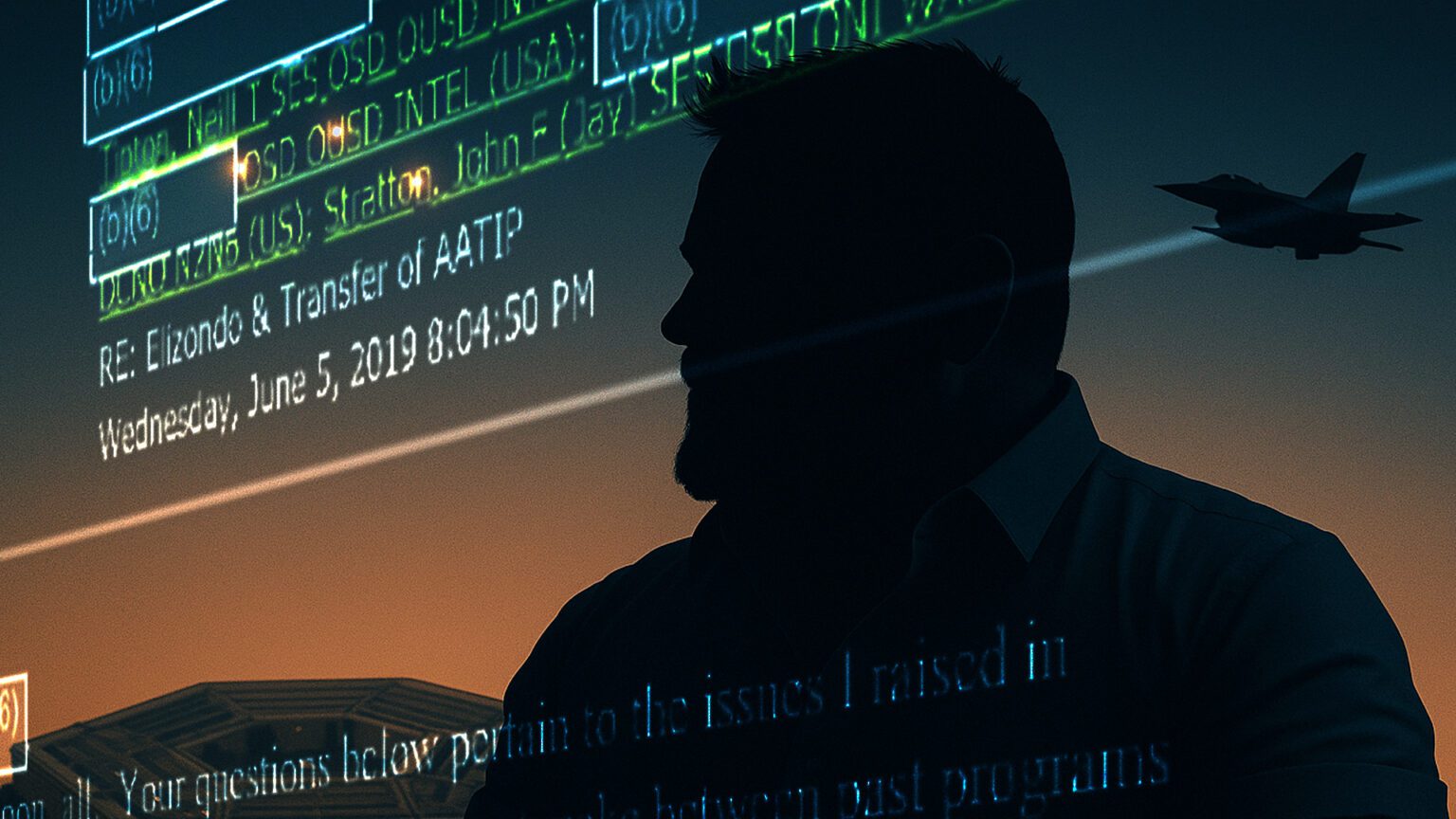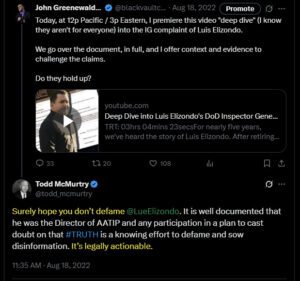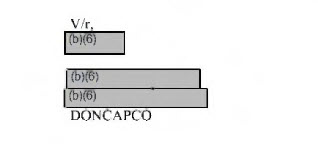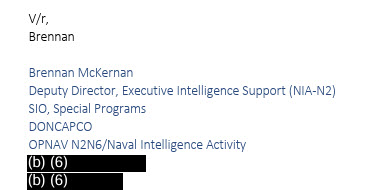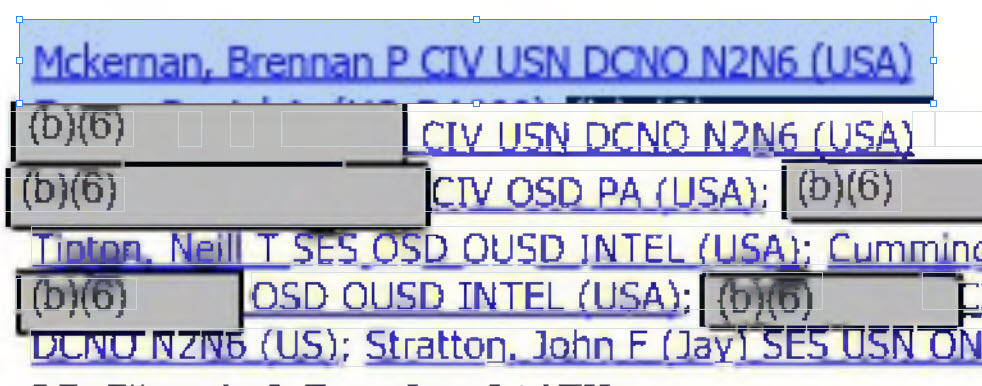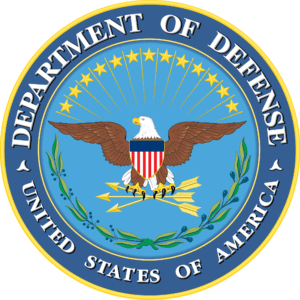
Newly released internal emails from the Department of Defense, obtained through a FOIA request filed by The Black Vault, shed new light on two key aspects of the UAP issue: previously undisclosed (never officially acknowledged) briefings by Navy pilots to the Secretary of Defense’s front office, and the continued controversy surrounding former intelligence officer Luis Elizondo’s role in those efforts. While the documents, released under case number 25-F-2554, confirm Elizondo’s involvement in UAP related activity, they also reinforce longstanding questions about the nature and formality of that role which raise new distinctions between ‘informal coordination’ and ‘leadership’ of an official DoD “program,” as often claimed in media reports since 2017.
Among the key revelations in the documents is a 2019 internal communication from a Department of the Navy representative identified only by the signature block “DONCAPCO.” While the author’s identity remains officially redacted, contextual clues point toward a likely, but unconfirmed, connection to Brennan McKernan. McKernan later succeeded Jay Stratton as director of the UAP Task Force in 2021. McKernan’s email signatures in other FOIA releases match the format seen in this new release, and the title “DONCAPCO” has not appeared publicly elsewhere outside of The Black Vault’s archives and one secondary Reddit post referencing the same, all of which show a confirmed McKernan’s email signature block that was released to The Black Vault via the FOIA. A Google search of “DONCAPCO” shows those three results. The likelihood of it being a match to McKernan is highly likely, but again, not confirmed. Given his position, if it is McKernan, the feedback he provides in these emails is highly relevant.
Note: To address the blatant mismatch on the number of lines between the emails, this is likely easily explained with assignment duty changes within the 2 year span between the emails sent. The 2019 email likely reads with the first line shown, “V/r”. The second line is likely “Brennan”. The third line is likely “Brennan McKernan”. The fourth line is likely “SIO/Special Programs”. And the fifth line is shown as DONCAPCO. When compared to the 2021 email, if this speculation is true, the redaction lengths match up to the the same corresponding lines. The additional titles likely were added later for McKernan through promotions, reassignments, or both.
In the June 2019 email, this DONCAPCO official wrote, “Mr. Elizondo did play a role in facilitating connections and introductions to other DoD elements that were working CI/safety issues similar to those encountered by Navy… In this regard, Mr. Elizondo was very useful.” The message further describes Elizondo as maintaining “a solid reputation up until he made a sudden, shocking departure in October 2017.”
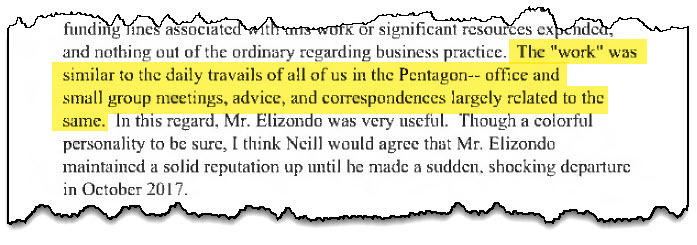
While this internal comment acknowledges UAP-related coordination by Elizondo, it carefully avoids any reference to formal leadership or program authority. There is no mention of a budget, office infrastructure, or command over a sanctioned initiative, all of which are elements typically associated with an official “program.” The description paints a picture of informal facilitation rather than structured program management. This framing stands in sharp contrast to years of media coverage asserting that Elizondo was the former “director” of a secret UFO program within the Pentagon, specifically, the Advanced Aerospace Threat Identification Program (AATIP).
In addition, these internal records also contradict Elizondo’s claim during a 2018 MUFON keynote speech that $22 million went to AATIP and outlined what it bought. “This is what your 22 million dollars worth of tax money was spent on,” Elizondo told the MUFON audience. However, official documents and official statements later disproved this claim as it was money that funded the AAWSAP, not AATIP, a distinction worth emphasizing since Elizondo has sternly stated he “was not part of AAWSAP!”. These emails from the “DONCAPCO” official further confirms that there were “no funding lines associated with [Elizondo’s] work” on AATIP and no “significant resources” were expended.
As stated earlier in this article, Elizondo has long claimed that he was the director of AATIP until his resignation in October 2017. However, according to prior Pentagon statements and reaffirmed by multiple sources in these emails, “AATIP” (or more accurately referred to as AAWSAP) ceased receiving funding in 2012, according to the DoD. What followed, the documents suggest, may have been individual efforts, possibly spearheaded or maintained by Elizondo, but understood and referenced internally more as an “activity” or personal initiative than an authorized continuation of AATIP. As the DONCAPCO official explained about Elizondo’s contribution, “The ‘work’ was similar to the daily travails of all of us in the Pentagon — office and small group meetings, advice, and correspondences largely related to the same.”
This information was given in response to another 2019 email, believed to be authored by Pentagon spokesperson Susan Gough, who asked key clarifying questions of Navy officials not only about Elizondo, but also about a UAP briefing of then-Secretary of Defense (SECDEF) James Mattis and/or his ‘front office’:
“… Are you aware of any briefings on UAPs/AATIP to then-SECDEF Mattis’ front office in general, and in particular, do [you] have any knowledge/reports/documentation that two Navy pilots briefed the SECDEF front office on any UAP incidents in the 2016-2017 time frame?”
In response, the DONCAPCO official provided what may be the first official written confirmation that such a briefing occurred:
“I am aware of office discussions that occurred at the request of OSD leadership. I escorted the pilots myself.”
This understated but significant comment marks a potential first in an official document, verifying that military pilots did, in fact, brief the Secretary of Defense’s front office on UAP issues prior to Elizondo’s resignation. While it remains unclear how senior the attendees were, the acknowledgment alone provides new evidence that top Pentagon leadership was aware of, and receiving briefings on, pilot-reported UAP encounters in the months leading up to the 2017 public rollout of the now-famous Navy videos.
This meeting was also referred to by Elizondo in his DoD/IG complaint, filed to the Inspector General in 2021, and later published in redacted form by the NY Post in 2022. Until now, the meeting was never officially confirmed.
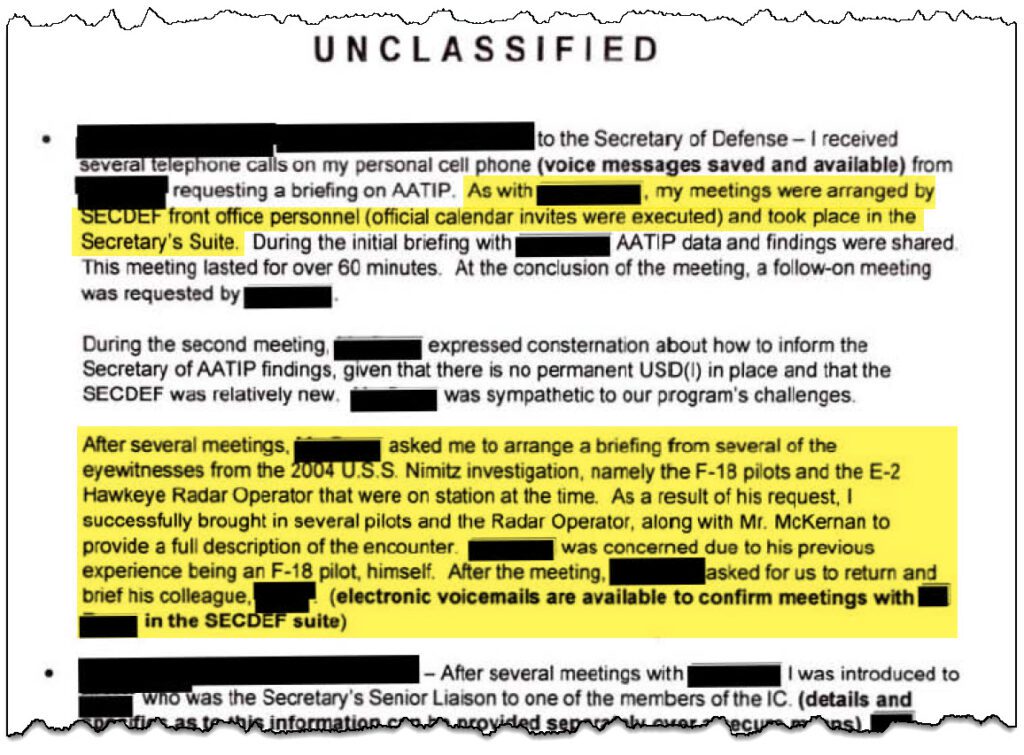 Other documents included in the release contain extended email exchanges between Elizondo and Neill Tipton, a senior civilian in OUSD(I), from August and September 2017. In those, Elizondo outlines a plan to transfer his UAP-related efforts to Tipton, who expressed some uncertainty about what the “program” actually was. “At some point I need to know what this actually ‘is’,” Tipton wrote.
Other documents included in the release contain extended email exchanges between Elizondo and Neill Tipton, a senior civilian in OUSD(I), from August and September 2017. In those, Elizondo outlines a plan to transfer his UAP-related efforts to Tipton, who expressed some uncertainty about what the “program” actually was. “At some point I need to know what this actually ‘is’,” Tipton wrote.
These emails have leaked before to the general public (in part), were published along with Elizondo’s DoD/IG complaint, and they were later released via FOIA to The Black Vault after an extensive investigation that eventually led to their official release.
The question ‘what exactly AATIP was’, and whether Elizondo led the UFO program, or if it was a “program” at all, has fueled years of debate. These newly released communications emphasize the internal lack of clarity even among Pentagon insiders. While Elizondo asserts in one email he wrote to the Pentagon that “AATIP was an official program that was never shut down,” and on his website he states that he was the “former senior leader of the Advanced Aerospace Threat Identification Program (AATIP)”, the language from other officials leans toward characterizing his post-2012 involvement as informal and unsupported by a specific line of funding and primarily consisted of “office and small group meetings, advice, and correspondences largely related to the same.”
For years, scrutiny of the Pentagon’s statements about Elizondo has largely focused on Susan Gough and Garry Reid… two figures frequently accused of undermining his credibility in a strategic disinformation campaign. In a previous Black Vault investigation, internal memos written by Reid revealed that some officials raised security concerns and confusion about Elizondo’s public claims, further fueling the controversy, but some argued that any information rooted to Gough and/or Reid was simply a lie as it was crafted to attack the credibility of Elizondo.
However, these newly released documents show that assessments of Elizondo’s role were not limited to those two individuals. A 2019 email, likely authored by Brennan McKernan, who later became director of the UAP Task Force, describes Elizondo’s efforts as helpful but informal, involving coordination and introductions rather than the leadership of an official program. McKernan’s apparent involvement, given his later position and his separation from Gough and Reid’s respective chains of command, suggests that the Pentagon’s interpretation of Elizondo’s role was more widely held across different sectors of the Department.
While this release appears to confirm that Elizondo remained actively engaged in UAP-related efforts until his resignation in 2017, it continues to fall short of validating the widely circulated claim that he led a formal, Pentagon-sanctioned, and funded program. At the same time, it introduces what may be the first documented reference to Navy pilots briefing the Secretary of Defense’s front office on UAP encounters during that same period… an acknowledgment that raises new questions about how high the issue had traveled within the Department, who exactly was involved… and when.
###
The FOIA release package is below, followed by a small list of other extensive investigations into these issues. Lastly, as noted in the FOIA release letter, 61 additional pages were forwarded to the U.S. Army for review and potential release. Those records will be posted, when available, if released.
Document Archive
 25-F-2554 Release Package [19 Pages, 1.8MB]
25-F-2554 Release Package [19 Pages, 1.8MB]
 Loading...
Loading...
Other InvestigationsThis release follows multiple prior investigations by The Black Vault that has spanned many years, which include:
|
Follow The Black Vault on Social Media:

